Berkeleyan
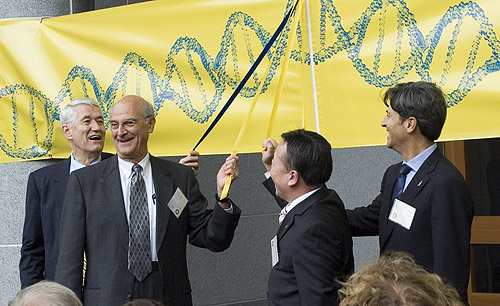 At last Friday’s Stanley Hall dedication, Chancellor Birgeneau, Whitaker Foundation President Peter Katona, donor Richard S. Liu, and David Crane, special adviser to Gov. Schwarzenegger for jobs and economic growth, “unzipped” the double-helix ribbon barring the entrance. (Deborah Stalford photo) |
Stanley Hall: Cutting-edge by design
The first phase of a large-scale effort to modernize teaching and research in the health sciences, it's a building intended to foster interaction
![]()
| 03 October 2007
When Stanley Hall, the newest science building on the Berkeley campus, was officially dedicated on Friday, Sept. 28, it was hailed as something more than an enclosure for much-needed laboratory, office, and classroom space.
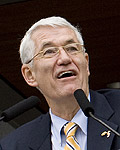 "Today, life-science research is progressing toward problems of increasing scale and complexity, with solutions rooted in the quantitative sciences: mathematics, physics, chemistry, and engineering. The research that will be stimulated here, at the crossroads of multiple disciplines, holds the promise of transforming human health, energy, and the environment." -Chancellor Robert Birgeneau
|
Located at the East Gate entrance to campus, the building is the Berkeley home of the California Institute for Quantitative Biosciences (QB3) and the relatively young Department of Bioengineering. A public-private partnership between three UC campuses (Berkeley, San Francisco, and Santa Cruz) and industry, QB3 is one of four California Institutes of Science and Innovation launched by the state in 2000.
Supported by a combination of state and private funds, the $162.3 million Stanley Hall is considered one of the few biophysical science research facilities in the United States. It is also the first building on campus in which decisions about space allocation will be made on the basis of how such decisions will support a multidisciplinary program, rather than being controlled by a department or college.
"Designing a building to truly foster interdisciplinary research isn't about dividing up lab and office space among different departments," says Susan Marqusee, associate director of QB3, professor of molecular and cell biology, and the faculty leader on the Stanley Hall replacement project. (The original Stanley Hall, named for the late Wendell M. Stanley, a Berkeley biochemist and virologist who received the Nobel Prize in Chemistry in 1946, was built in 1952 and demolished in 2003, having been identified as seismically unsafe.)
"We actually dispensed with the notion of departments altogether and instead focused on the different types of science that would take place in the facility," she continues. Marqusee, a leading expert on research in protein folding, worked closely on the building's design with the faculty and the architectural firm Zimmer Gunsul Frasca Architects LLP.
Instead of being clustered by discipline, researchers are dispersed throughout the building in "neighborhoods" where they work alongside colleagues in other fields. Their space is flexible in order to evolve with the science. Each neighborhood includes three to four research labs, equipment rooms, office and conference space, and a shared workroom that serves as a "community center" where researchers can interact.
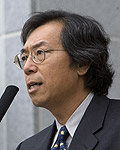 "This is an extraordinary building that will maximize scientific exchange and discourse among structural biologists, chemists, physicists, bioengineers, and computational biologists." -Professor of Biochemistry and Molecular Biology Robert Tjian |
The new building is even being viewed by some as a leg up for the campus in its ongoing competition with other top universities for the best and brightest faculty and graduate students. That aspect was played up by the keynote speaker at Saturday's open house, Merck Research Laboratories President Peter Kim, who was a faculty researcher at MIT during the time that Berkeley Chancellor Robert Birgeneau was dean of science there.
"Looking at this building," said Kim, "it can only be described by this former MIT professor as an unfair advantage in that [recruitment] battle. What biologist, chemist, engineer, or physicist wouldn't want to work in a place like this?"
The Gang of Three
Planning for the new Stanley Hall - which, at approximately 285,000 gross square feet, is more than four times the size of its predecessor - began in the late 1990s with a "romantic vision" championed by three distinguished Berkeley faculty members: Paul Gray, professor of electrical engineering, who was then dean of the College of Engineering; Graham Fleming, professor of chemistry; and the late Daniel Koshland Jr., professor of molecular and cell biology. Dubbed the "Gang of Three," they proposed a building that would not only enable collaborations among scientists from different disciplines but would make such alliances inevitable.
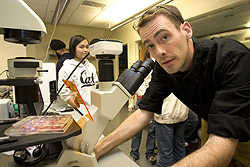 Terry Johnson, a bioengineering lecturer, in one of Stanley Hall's modern instructional labs. (Jim Block photos) |
As an example, Fleming notes that approaching cellular components as one would the parts of an electronics chip and then manipulating them to behave in new ways has formed the basis of a fledgling new field of research - synthetic biology. And computational biology, which incorporates the techniques of computer science, mathematics, and statistics into the field of biology, was critical to the successful sequencing of the human genome.
"Making progress toward solving the grand challenges of biological sciences pushes the limits of each discipline," he says. "Finding solutions that reach beyond these limitations requires scientific engagement by scientists who are not only experts in their fields, but who can work conversantly across fields. Stanley Hall and QB3 create an environment that supports this intellectual engagement."
Breaking down boundaries
 "Our vision was to bring together our most creative researchers, give them state-of-the-art facilities, physical space to support their interaction, and a support system that crosses traditional institutional boundaries." -Professor of Chemistry Graham Fleming, Berkeley director of QB3
|
The Stanley Hall project also represents phase one of the UC Berkeley Health Sciences Initiative, a $400 million campus-wide fundraising campaign to support the construction of two new interdisciplinary research centers here: Stanley Hall and the Li Ka Shing Center for Biomedical and Health Sciences. Groundbreaking for the latter facility, to be built on the site of old Warren Hall, is scheduled for early 2008.
Stanley Hall houses specialized core research facilities, including a nuclear magnetic resonance (NMR) facility that was specifically designed to house a powerful, 900 megahertz magnet, one of only a few in operation worldwide. (See "Subatomic particles and giant magnets".) The 7-ton device, funded by a $6 million grant from the National Institutes of Health, will be used by researchers throughout Central and Northern California.
Other support facilities at Stanley Hall include the Biomolecular Nanotechnology Center, dedicated to the fabrication of bio-MEMS and microrobotic devices; the Keck MacroLab, designed to support protein expression studies; the Vincent Coates Functional Genomics Center; and mass-spectrometry and proteomics facilities.
Scientists from other universities and industry will have opportunities to use the Stanley Hall facilities, Fleming says, which will stimulate active partnerships between these researchers.
Jeanne Stachowiak, a Ph.D. student in mechanical engineering and a member of bioengineering associate professor Dan Fletcher's lab on the sixth floor of Stanley Hall, says the sharing of equipment and expertise has already become commonplace in the building.
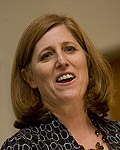 "In this building, we leave behind the way we usually think about doing things in our individual departments and do them the way the science is driving us." -Professor of Molecular and Cell Biology Susan Marqusee, associate director of QB3 |
"If we weren't on the same floor, or even in the same building, it would be less likely that we'd even know about each other's resources," says Stachowiak. "The way the space is configured lets students build their own collaboration. We talk while having lunch, and we might find out that a particular lab has a tool that could be useful in our research. It helps students create their own community." (See "A building with its own fan club".)
For Professor Marqusee, the official opening of Stanley Hall represents the culmination of an exciting vision. "This building has been my passion for the last 10 years. It embodies the best of how science can affect the design of a building, and how the design of a building can transform the science that takes place within its walls," she says.
She notes, however, the significant absence of Daniel Koshland, one of Stanley Hall's most enthusiastic champions. An eminent biochemist and a former editor of the journal Science, he died two months ago.
"I'm glad that Dan Koshland was able to see the vision realized, even though he won't be able to witness and enjoy the rewards that promise to come from what we've created here in Stanley Hall," says Marqusee, who worked closely with Koshland on this project and considers him a mentor. "It's been an amazing and rewarding journey."

